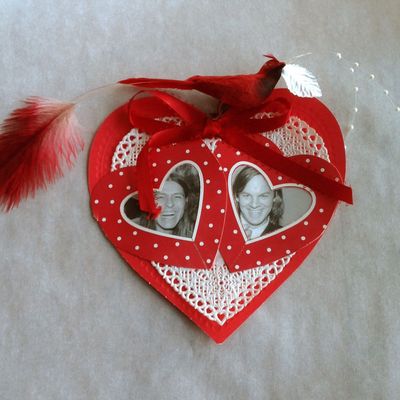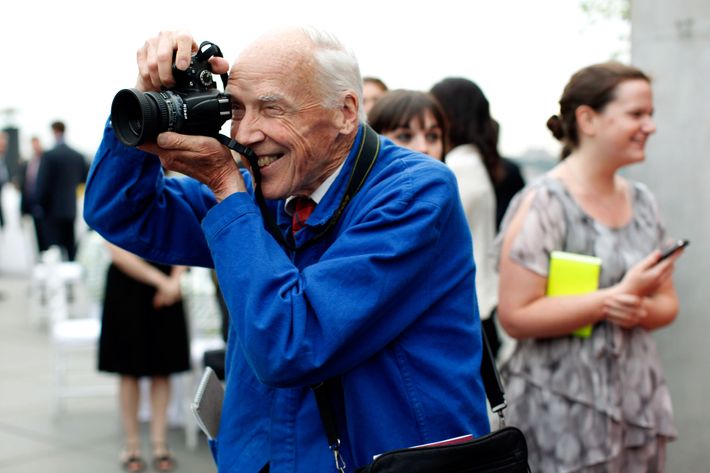
Bill Cunningham, the 83-year-old originator of street-style photography, has probably never celebrated Valentine’s Day like the rest of us. In the 2010 documentary, Bill Cunningham New York, he comes across as the fashion world’s equivalent of a monk, religiously devoted to his craft. And when Richard Press, the director, asks if he’s ever had a romantic relationship, Bill demurs: “Do you want to know if I’m gay?” he answers. “Isn’t that a riot … no, I haven’t … it never occurred to me.”
Regardless of his sexuality or relationship history, though, Bill definitely knows what love means. Especially between gay men. In fact, he’s been a quiet pioneer when it comes to making sure their lives and loves have been covered in the Times, even long before the paper would print the word “gay.”
I first got a sense of Bill’s heart when I went to work with him in the Style department of the New York Times twenty years ago. Around the gloomy office, several women had handmade valentines pinned to their desk bulletin boards. I wondered if this was because the trailblazing feminist reporters were Ms. Lonelyhearts married to their careers, but soon I learned these elaborate paper constructions were made by Bill. (Before he was a photographer, he was an avant-garde milliner in the fifties with a society clientele, and he crafted these cards with the same whimsy as the hats at his salon.) The women who received Bill’s valentines relished his affection; if any men got cards from Bill, they certainly did not display them.
One Valentine’s Day, in 1995, Bill approached me in the newsroom. I was an assistant editor who’d been typing his captions for a couple of years, but I didn’t know if he saw me as more than just another one of the “kids” he patted on the shoulder as he raced around town on his bicycle.
“Can I ask you a question, young man?” he asked. “That Brazilian fellow — is he your special friend?” He was referencing my then-boyfriend, Carlos Emilio, a photographer whom Bill had seen me with at parties. I told him yes.
“That’s what I thought,” said Bill as he unzipped the worn, vinyl shoulder bag he always carried. He pulled out an eight-by-ten manila envelope with the New York Times logo, and he handed it to me. Inside, I found the most extraordinary valentine. There was a red cardboard heart about eight inches wide with a doily pasted on it, and then two polka-dot hearts that were inset with a cut-out black-and-white photo of Carlos and a matching photo of me. I was awestruck and dumbstruck by this quiet gesture: Bill had been paying close attention to my romantic life.

It wasn’t just my romantic life, though. If you study Bill’s career at the Times, he emerges as an incognito activist who has celebrated gay pride week after week even as he excused himself from the increasingly sexualized society that he chronicled. Without being partisan or political, he has raised awareness of the vital role of gays in New York’s culture.
In 1979, for example, he accompanied reporter Suzanne Slesin to Fire Island Pines for a sunrise-to-sunset fund-raising party. Although the Pines was — then as now — predominantly gay, the words gay and homosexual don’t appear in the article. (The newspaper did not start using the word gay as a synonym for homosexual until 1987.) But Bill’s photograph of Ron Martin, Michael Schaible, Robin Jacobsen, and Scott Bromley, their smiles framed by the telltale mustaches of the Village People generation, made it clear what was going on.
Those smiles began to disappear a few years later as the AIDS epidemic decimated the fashion industry. Bill, an insider who had been named the outstanding photographer of the year by the Council of Fashion Designers of America in 1983, bore witness as star designers like Angel Estrada, Halston, Perry Ellis, and Willi Smith withered away.
Two decades after the Stonewall riots, a new strain of homophobia was sweeping the city, and when the “Sunday Styles” section was born in 1992, Bill stealthily took every opportunity he could to bolster the gay community’s morale. Although he was technically a freelancer, he was given unprecedented real estate in the newspaper every week: a half page for his “On the Street” fashion column and two facing half pages for “Evening Hours” party pictures. He was his own boss in the hierarchical newsroom, and he made sure that AIDS benefits received as much coverage as galas at the Metropolitan Opera and Carnegie Hall.
He took pictures of Ann Magnuson and Eartha Kitt at the American Foundation for AIDS Research’s Boat House Rock party in Central Park, and he went out to Bellport Village, Long Island, for the Stopping AIDS Together benefit picnic and auction. He snapped Henry Kissinger posing with a Harley at a benefit for the New York Hospital-Cornell Medical Center AIDS Care Center, and the Shubert Organization’s Gerald Schoenfeld tossing dice at another casino fund-raiser to benefit Broadway Cares/Equity Fights AIDS. When he went to Paris in 1992 to cover the collections, he shot the Balade de l’Amour AIDS benefit at the Folies-Bergere.
The column’s “Evening Hours” mandate did not deter Bill from photographing the eleventh annual “Morning Party” on the beach in Fire Island Pines in 1993, which benefited the Gay Men’s Health Crisis. He devoted a half page to vaguely erotic pictures of muscled men dancing in colorful Versace bathing suits and raffia “hula” skirts, as well as one inventive fellow who wore a pleated skirt fashioned out of the Times itself. The event raised $265,000 for the charity, which he reported to justify the coverage in case anyone questioned his news judgment.
He also used his “On the Street” column to salute the gay community. He portrayed the Gay Men’s Health Crisis fund-raising walk on a rainy Sunday in May 1992 as a fashion parade with 20,000 participants. “Humor and originality, as in turning plastic trash bags into survival gear, added typical New York bravado to the spirit of optimism that prevailed in the annual AIDS Walk,” he wrote. He published pictures of the Wigstock party in the Village where drag queens camped in ensembles inspired by Chanel, John Galliano, and Marc Jacobs.
One of the sexiest “On the Street” columns Bill ever produced was published on Independence Day 1993. The headline read simply: “Men in Skirts.” All of the pictures had been taken at the Pride Parade of buff, bare-chested guys in short kilts and heavy work boots. Bill wrote the caption: “The imagery brought to mind ancient warriors depicted in Greek and Roman sculpture, now reflected in the gym-perfected bodies of today’s generation. The look reveals how a generation that worships the body perceives its image as that of the Uber-male.”
Looking back at his work, I’d say that all of Bill’s photographs are actually valentines. They’re how he shows his affection for the people of New York who love and revere him in return. He gave visibility to a generation of men who had been mostly invisible in the Times until then except as victims, oddballs, or closet cases. And, in doing so, revealed just as much about himself.




